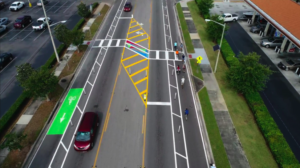
Complete Streets. You’ve heard of it, but you’re not exactly sure what it means or how it can benefit your community. Our friends at the National Complete Streets Coalition (NCSC) put together a handy Q&A to help understand some of the basics of Complete Streets.
#1 Who is the National Complete Streets Coalition?
The National Complete Streets Coalition, a program of Smart Growth America, is a non-profit, non-partisan alliance of public interest organizations and transportation professionals committed to the development and implementation of Complete Streets policies and practices.
We believe that the streets of our cities and towns must allow all people, regardless of age, ability, income, race or ethnicity, to safely, comfortably and conveniently access homes, employment centers, schools, shops, health facilities and other destinations by foot, bicycle, public transportation, car or truck. A community’s street network should reflect the current and planned built environments and support overall public and economic health.
#2 What are Complete Streets?
A nationwide movement launched by the Coalition in 2004, Complete Streets means putting people first whenever we plan, design, construct, operate and maintain our street networks.
#3 Who are Complete Streets for?
Complete Streets serve the needs of all people who use the road equitably, particularly the most historically underinvested and underserved communities and the most vulnerable users of our roads, including people walking or biking, older adults and people of color. Transportation choices should be safe, convenient, reliable, affordable, accessible and timely. These options should be available to all people, regardless of race, ethnicity, religion, income, gender identity, immigration status, age, ability, languages spoken or level of access to a personal vehicle.
#4 What does it mean to create Complete Streets?
Creating Complete Streets means transportation agencies must change their approach to community roads and think about streets as places for people, not just cars. By adopting a Complete Streets policy, communities direct their transportation planners and engineers to routinely design and operate the entire right of way to ensure all people can safely access the street, regardless of age, ability or mode of transportation. This means that every transportation project will make the street network better and safer for drivers, transit users, pedestrians, and bicyclists—making your town a better place to live. Read more about the benefits of Complete Streets.
 #5 What do Complete Streets look like?
#5 What do Complete Streets look like?
There is no singular design prescription for Complete Streets; each one is unique because it responds to its community context. A complete street may include:
- sidewalks
- bike lanes (or wide paved shoulders)
- special bus lanes
- comfortable and accessible public transportation stops
- frequent and safe crossing opportunities
- median islands
- accessible pedestrian signals
- curb extensions
- narrower travel lanes
- roundabouts
A complete street in a rural area will look quite different from a complete street in a dense, urban area, but both are designed to balance safety and convenience for everyone using the road (not just cars). Check out examples of Complete Streets case studies.
#6 Why would I want my community to have a Complete Streets policy?
Across the country and on Capitol Hill, Complete Streets policies have been gaining traction as more places realize the benefits of having safe, accessible and healthy streets in their communities.
With a Complete Streets policy in place, communities can work toward creating complete networks so people can safely and comfortably walk or bike anywhere they need to go. Complete Streets create opportunities for people to get physical activity in their day-to-day lives. They can connect people to schools, jobs, healthy foods, parks and other community amenities. And Complete Streets aren’t just safer and healthier – they also help create stronger economies, boosting jobs and revenue for local businesses.
#7 What’s in a Complete Streets policy?
Complete Streets can be achieved through a variety of policies:
- ordinances and resolutions
- rewrites of design manuals
- inclusion in comprehensive plans
- internal memos from directors of transportation agencies
- policies adopted by city and county councils
- and executive orders from elected officials, such as Mayors or Governors.
The strongest policies should include ten core elements, including identifying the most vulnerable users who the policy will benefit, committing to implement the policy in all transportation projects, working together with private developers and other jurisdictions, defining how the policy will measure success and setting up the next steps needed to implement the policy. Download the 10 elements.
#8 Does my community have a Complete Streets policy?
The National Complete Streets Coalition maintains an inventory of adopted Complete Street policies across the U.S. In total, over 1400 Complete Streets policies have been passed in the United States, including those adopted by 33 state governments, the Commonwealth of Puerto Rico, and the District of Columbia. View Complete Streets policy atlas.

#9 Okay, I’m convinced. My community needs a Complete Streets policy. Where do I start?
Our policy framework, the Elements of a Complete Streets Policy, is an excellent place to start. Based on decades of collective expertise in transportation planning and design, the ten elements serve as a national model of best practices that can be implemented in nearly all types of Complete Streets policies at all levels of governance.
Eager for more information? You can subscribe to the National Complete Streets Coalition newsletter and follow them on twitter. The coalition also works directly with communities to help them develop, adopt and implement strong Complete Streets policies. Learn more about their technical assistance work.


